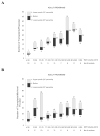National Survey of Hematopoietic Cell Transplantation Center Personnel, Infrastructure, and Models of Care Delivery
- PMID: 25840337
- PMCID: PMC4466059
- DOI: 10.1016/j.bbmt.2015.03.020
National Survey of Hematopoietic Cell Transplantation Center Personnel, Infrastructure, and Models of Care Delivery
Abstract
Hematopoietic cell transplantation (HCT) is a complex procedure that requires availability of adequate infrastructure, personnel, and resources at transplantation centers. We conducted a national survey of transplantation centers in the United States to obtain data on their personnel, infrastructure, and care delivery models. A 42-item web-based survey was administered to medical directors of transplantation centers in the United States that reported any allogeneic HCT to the Center for International Blood and Marrow Transplant Research in 2011. The response rate for the survey was 79% for adult programs (85 of 108 centers) and 82% for pediatric programs (54 of 66 centers). For describing results, we categorized centers into groups with similar volumes based on 2010 total HCT activity (adult centers, 9 categories; pediatric centers, 6 categories). We observed considerable variation in available resources, infrastructure, personnel, and care delivery models among adult and pediatric transplantation centers. Characteristics varied substantially among centers with comparable transplantation volumes. Transplantation centers may find these data helpful in assessing their present capacity and use them to evaluate potential resource needs for personnel, infrastructure, and care delivery and in planning for growth.
Keywords: Care delivery models; Hematopoietic cell transplantation; Infrastructure; Personnel; Survey; Transplantation center.
Copyright © 2015 American Society for Blood and Marrow Transplantation. Published by Elsevier Inc. All rights reserved.
Figures








References
-
- Pasquini MC, Wang Z. Current use and outcome of hematopoietic stem cell transplantation: CIBMTR Summary Slides. 2013 Available at: http://www.cibmtr.org.
-
- Majhail NS, Murphy EA, Denzen EM, et al. The National Marrow Donor Program’s Symposium on Hematopoietic Cell Transplantation in 2020: a health care resource and infrastructure assessment. Biol Blood Marrow Transplant. 2012;18:172–82. - PubMed
-
- Gajewski JL, Lemaistre CF, Silver SM, et al. Impending Challenges in the Hematopoietic Stem Cell Transplant Physician Workforce. Biol Blood Marrow Transplant. 2009;15:1493–501. - PubMed
Publication types
MeSH terms
Grants and funding
LinkOut - more resources
Full Text Sources
Other Literature Sources
Medical

